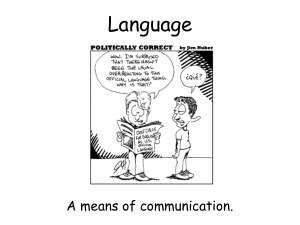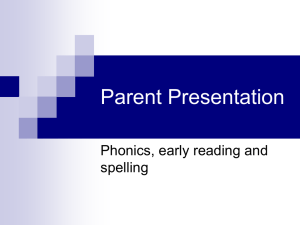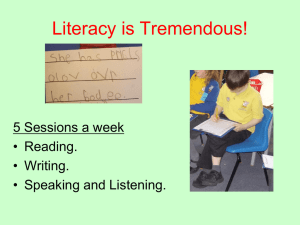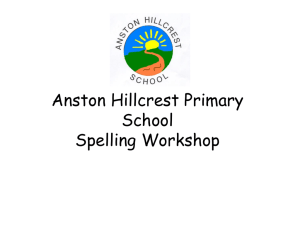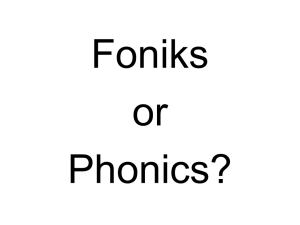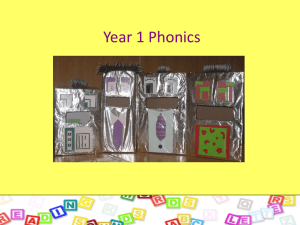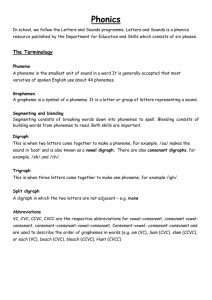Phonics-observation
advertisement
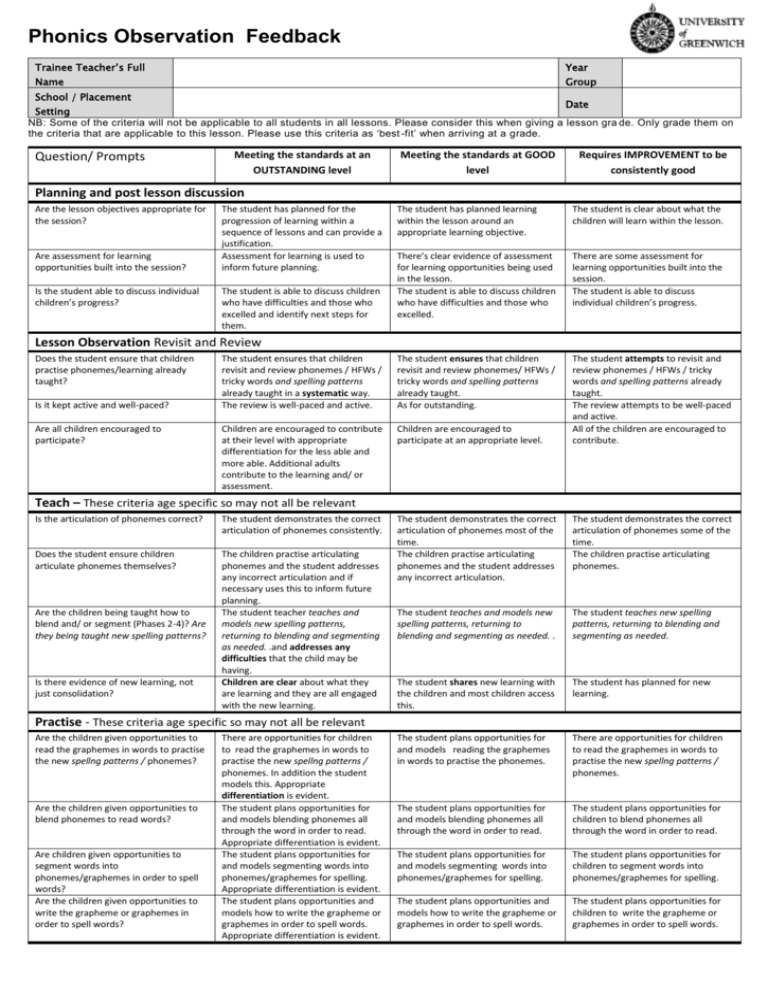
Phonics Observation Feedback Trainee Teacher’s Full Year Name Group School / Placement Date Setting NB: Some of the criteria will not be applicable to all students in all lessons. Please consider this when giving a lesson gra de. Only grade them on the criteria that are applicable to this lesson. Please use this criteria as ‘best -fit’ when arriving at a grade. Question/ Prompts Meeting the standards at an OUTSTANDING level Meeting the standards at GOOD level Requires IMPROVEMENT to be consistently good Planning and post lesson discussion Are the lesson objectives appropriate for the session? Are assessment for learning opportunities built into the session? Is the student able to discuss individual children’s progress? The student has planned for the progression of learning within a sequence of lessons and can provide a justification. Assessment for learning is used to inform future planning. The student has planned learning within the lesson around an appropriate learning objective. The student is clear about what the children will learn within the lesson. There’s clear evidence of assessment for learning opportunities being used in the lesson. The student is able to discuss children who have difficulties and those who excelled. There are some assessment for learning opportunities built into the session. The student is able to discuss individual children’s progress. The student ensures that children revisit and review phonemes / HFWs / tricky words and spelling patterns already taught in a systematic way. The review is well-paced and active. The student ensures that children revisit and review phonemes/ HFWs / tricky words and spelling patterns already taught. As for outstanding. Children are encouraged to contribute at their level with appropriate differentiation for the less able and more able. Additional adults contribute to the learning and/ or assessment. Children are encouraged to participate at an appropriate level. The student attempts to revisit and review phonemes / HFWs / tricky words and spelling patterns already taught. The review attempts to be well-paced and active. All of the children are encouraged to contribute. The student is able to discuss children who have difficulties and those who excelled and identify next steps for them. Lesson Observation Revisit and Review Does the student ensure that children practise phonemes/learning already taught? Is it kept active and well-paced? Are all children encouraged to participate? Teach – These criteria age specific so may not all be relevant Is the articulation of phonemes correct? The student demonstrates the correct articulation of phonemes consistently. Does the student ensure children articulate phonemes themselves? The children practise articulating phonemes and the student addresses any incorrect articulation and if necessary uses this to inform future planning. The student teacher teaches and models new spelling patterns, returning to blending and segmenting as needed. .and addresses any difficulties that the child may be having. Children are clear about what they are learning and they are all engaged with the new learning. Are the children being taught how to blend and/ or segment (Phases 2-4)? Are they being taught new spelling patterns? Is there evidence of new learning, not just consolidation? The student demonstrates the correct articulation of phonemes most of the time. The children practise articulating phonemes and the student addresses any incorrect articulation. The student demonstrates the correct articulation of phonemes some of the time. The children practise articulating phonemes. The student teaches and models new spelling patterns, returning to blending and segmenting as needed. . The student teaches new spelling patterns, returning to blending and segmenting as needed. The student shares new learning with the children and most children access this. The student has planned for new learning. The student plans opportunities for and models reading the graphemes in words to practise the phonemes. There are opportunities for children to read the graphemes in words to practise the new spellng patterns / phonemes. The student plans opportunities for and models blending phonemes all through the word in order to read. The student plans opportunities for children to blend phonemes all through the word in order to read. The student plans opportunities for and models segmenting words into phonemes/graphemes for spelling. The student plans opportunities for children to segment words into phonemes/graphemes for spelling. The student plans opportunities and models how to write the grapheme or graphemes in order to spell words. The student plans opportunities for children to write the grapheme or graphemes in order to spell words. Practise - These criteria age specific so may not all be relevant Are the children given opportunities to read the graphemes in words to practise the new spellng patterns / phonemes? Are the children given opportunities to blend phonemes to read words? Are children given opportunities to segment words into phonemes/graphemes in order to spell words? Are the children given opportunities to write the grapheme or graphemes in order to spell words? There are opportunities for children to read the graphemes in words to practise the new spellng patterns / phonemes. In addition the student models this. Appropriate differentiation is evident. The student plans opportunities for and models blending phonemes all through the word in order to read. Appropriate differentiation is evident. The student plans opportunities for and models segmenting words into phonemes/graphemes for spelling. Appropriate differentiation is evident. The student plans opportunities and models how to write the grapheme or graphemes in order to spell words. Appropriate differentiation is evident. Apply - These criteria age specific so may not all be relevant Do the children have opportunities to apply their phonics knowledge and skills in reading and writing? The student plans opportunities for and models how to apply phonics knowledge and skills in reading and writing . Appropriate differentiation is evident. The student plans opportunities for and models how to apply phonics knowledge and skills in reading and writing . The student plans opportunities for children to apply their phonics knowledge and skills in reading and writing activities. Is the lesson multi-sensory, fun and interactive but tightly focused on the learning objective? The student incorporates fun, multi sensory interactive activities which effectively support the learning The student incorporates fun, multi sensory interactive activities. Do activities promote speaking and listening? Speaking and listening strategies are used to support the children with reading and/or writing. Appropriate differentiation is evident. The student incorporates fun, multi sensory interactive activities which are designed to support the learning objectives. Speaking and listening strategies support the children with reading and/or writing. Throughout the lesson There is some evidence that speaking and listening strategies to support reading and writing. Other comments: Areas of strength: Areas for development: Student’s reflection on observation and impact of teaching on pupil progress: Targets for future development: How targets will be achieved: The student is making sufficient/insufficient progress to be consistently ‘Good’ for this stage of their development. (please delete as appropriate) LESSON GRADE OUSTANDING (1) GOOD (2) RI TO BE CONSISTENTLY GOOD (3) INADEQUATE (4) Observer Signed___________________________ Print Name _________________________ Role ____________________ Student Teacher Signed___________________________ Print Name__________________________ Joint Observation? YES / NO

